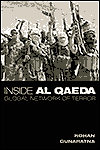|
|
J&K:
Jehadis Strike as Kashmir Recedes from Global Focus
Kanchan Lakshman
Research Associate, Institute for Conflict
Management;
Assistant Editor, Faultlines: Writings on Conflict & Resolution
Even as global
attention remains focused on the war on Iraq, the trajectory of
Jehadi terrorism in Jammu and Kashmir (J&K) is beginning to soar.
Two dramatic incidents in the space of 12 hours on Sunday, March 23,
2003, demonstrate the strengthening trends to escalation of terrorism in
the State. Former Hizb-ul-Mujahideen (HM)
Salar-e-Ala or chief commander, Abdul Majeed Dar, was shot dead by
unidentified gunmen in the Noor Bagh area of Sopore township in north
Kashmir when two gun-wielding youth barged into his ancestral house and
fired indiscriminately, killing Dar on the spot and critically injuring
his mother and sister. In the second incident, at least 24 Kashmiri
Pandits were killed at the Nandimarg village near Shopian in the Pulwama
district around midnight. The terrorists first snatched the policemen's
weapons and later fired indiscriminately on the Pandits. The dead
included 11 women and two children. According to preliminary reports,
approximately 25 heavily-armed terrorists dressed in police uniforms
descended on the tiny village, 75 km from the capital city of Srinagar,
and fired indiscriminately on the unarmed Pandits.
Two terrorist organizations have claimed responsibility for Dar's
killing: the hitherto little-known, 'Save Kashmir Movement', believed to
be a front of the Al Umar Mujahiddeen, while claiming responsibility,
labeled Dar as "an informant of Indian agencies" and "an enemy of the
Kashmiri people." Separately, a person describing himself as the
spokesperson of Al Nasireen, another obscure group, in a message to a
local news agency, said that activists of his group killed Dar for his
'anti-movement activities'. Meanwhile, another person claiming to be a
spokesperson for the HM called up the news agency and condemned Dar's
killing. Dar had been a front ranking terrorist in the HM before his
'expulsion' in May 2002. In his capacity as 'deputy supreme commander',
'Military adviser' and 'chief commander of operations', Dar played a
significant role in the indoctrination, recruitment, launching and
training of Hizb cadres. Reports suggest that, while managing the Hizb
training camps in Pakistan, he was the only Kashmiri terrorist who had
direct access to Prime Minister Nawaz Sharief as also General Pervez
Musharraf.
Dar's killing is the culmination of an almost three-year old battle for
supremacy being waged by his followers against the faction led by Syed
Salahuddin, the HM 'supreme commander' and chief of the 14-member United
Jehad Council (UJC),
a conglomerate of Pakistan-based terrorist organisations. Abdul Majeed
Dar came into prominence when he returned from Pakistan three years ago
to announce a unilateral cease-fire with Indian security forces on July
24, 2000. On August 3, 2000, a high-level official team of the
Government of India, headed by the then Union Home Secretary Kamal Pande,
visited Srinagar and conducted a meeting with Dar and his associates at
the Nehru Guest House. However, on August 8, 2000, Syed Salahuddin
'withdrew' the cease-fire at a Press Conference in Islamabad. The Dar
initiated 'peace talks' led to dissent within the Hizb, with the
Pakistani ranks fearing that an effective process of negotiations may
actually be established, to the detriment of Pakistani interests.
Subsequently, a war for supremacy ensued within the HM, and a
distinctive 'bimodal' operating structure emerged, with separate
factions owing allegiance to Dar and Salahuddin. Since the ill-fated
peace talks, followers of Salahuddin - who operates from Pakistan - and
Majeed Dar, who remained 'underground' in the Kashmir Valley, have had a
series of internecine clashes. In November 2002, two Salahuddin
loyalists were killed in factional conflict reported at the Mirpur and
Tarbela camps in Pakistan occupied Kashmir (PoK). The Hizb leadership in
Pakistan has also issued statements claiming Dar's alleged alignment
with Indian intelligence agencies. Reports suggest that Dar had been
disillusioned with the Pakistani Inter Services Intelligence (ISI) and
its military leadership. Dar was 'suspended' by the Salahuddin faction
and replaced by Saiful Islam as the Hizb 'chief commander of operations'
in Kashmir, on May 4, 2002. Two of his close associates, Assad Yazdani
and Zaffar Abdul Fatah, were also 'removed' from positions of command.
Again, on May 9, 2002, the Hizb leadership expelled another two
'divisional commanders' in south Kashmir. Even as Dar and his associates
were accused of assisting Indian security forces, many of his loyalists
were killed by cadres of the Salahuddin group. Faced with Dar's rising
popularity within the HM ranks, Salahuddin and the ISI had, in the
recent months, initiated several moves to marginalize and target Dar and
his associates in the terrorist ensemble.
The Salahuddin's faction is also widely believed to have carried out the
January 31, 2003 killing of the editor of News and Feature Alliance
(NAFA), Parvaz Mohammad Sultan, in Srinagar. NAFA had been
prominently reporting on the internal feud in the HM for the preceding
two weeks prior to Sultan's killing. The NAFA reports had mentioned that
the Valley-based faction led by Dar had 'overthrown' the Salahuddin
faction.
Within hours of Majeed Dar's murder, sources indicate that clashes broke
out at HM camps in PoK between the slain leader's followers and the
faction led by Salahuddin. Violent confrontations are believed to have
taken place at camps in Kotli, Mirpur, Oggi, Jungal-Mangal, Haripur and
Gadhi-Dupatta. Preliminary reports indicate that Salahuddin was fidgety
over the prospect of an imminent test of strength in the camps. Details
of casualties and the outcome of these clashes were still not available
at the time of this report.
The brief lull in Jehadi violence in J&K over the December -
February period was tactical, primarily the result of adverse weather
conditions along the passes on the border. However, Chief of Army Staff,
General N.C. Vij, on March 23, 2003, had stated that there would be a
spurt in infiltration into J&K from across the border after the snow
started melting, and this has been borne out by trends in March itself -
much earlier than had been usual in preceding years. Infiltration along
the Indo-Pakistan Line of Control (LoC) and border has increased with
the Lashkar-e-Toiba (LeT)
and Jaish-e-Mohammed (JeM)
stepping up their activities
in the State. As a result, the entire Jammu region, along with some
areas in Srinagar, Anantnag, Budgam, Pulwama, Baramulla and Kupwara
districts have been declared 'disturbed areas'. Reports indicate that
security forces are finding some difficulty in countering the renewed
threat perception after the Special Operations Group (SOG) of the J&K
Police was disbanded by the Mufti Mohammad Sayeed Government.
The massacre of Pandits is a continuation of the process of
ethnic cleansing
launched in January 1990 by Pakistan-backed terrorists. Such incidents
are clearly intended to block the proclaimed State Government policy to
facilitate a return of the Pandits to their homeland and may, in fact,
lead to a further exodus of Pandits from the Valley, as well as from
Muslim dominated areas in the Jammu region. Past incidents have shown
that the Hindus who have stayed back in the Valley are a priority target
for the terrorists, who lay claims to Kashmir as a 'Muslim land'. The
Pulwama massacre is a setback for Chief Minister Mufti Mohammad Sayeed,
who had made the 'safe return' of the Pandits a primary plank of his
campaign during the September-October 2002 Elections. The State
Government had recently drawn up plans to settle the Pandits around the
shrine at the holy spring at Tullamullah in Srinagar district and Mattan
in the Anantnag district, though the Pandits had displayed little
enthusiasm for the plan under the prevailing security situation in the
Valley. Their reluctance can only multiply manifold after Sunday night's
brutal massacre.
There has been much talk of the revival of the 'peace process' by
the Union Government [K.P.S.
Gill, "J&K: The Opportunities of Another Peace Process", SAIR 1.34],
after the appointment of a new interlocutor charged with initiating
negotiations with various political entities in J&K, as well as the new
Chief Minister's enthusiasm for a 'political solution' to the violence
in the State. But the mounting violence of the past three weeks
demonstrates again - as has been repeatedly established in the past -
that a search for solutions for the problems of J&K cannot, in fact, be
located in J&K. Such a solution will, indeed, remain elusive until the
infrastructure of terrorism located in Pakistan, and supported by the
state structure in Pakistan, is conclusively and irrevocably dismantled
and destroyed.
Courtesy:
South Asia Terrorism Portal |


